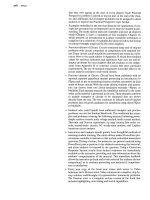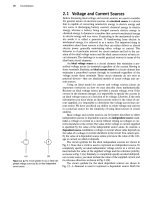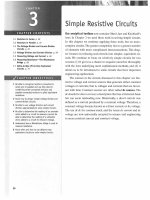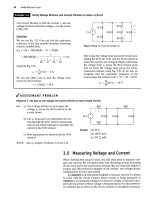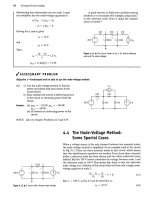Electric Circuits, 9th Edition P29 pdf
Bạn đang xem bản rút gọn của tài liệu. Xem và tải ngay bản đầy đủ của tài liệu tại đây (784.21 KB, 10 trang )
256 Response of First-Order
RL
and
RC
Circuits
Section 7.4
7.65 Repeat (a) and (b) in Example 7.10 if the mutual
inductance is reduced to zero.
7.66 There is no energy stored in the circuit in Fig. P7.66
PSPICE at the time the switch is closed.
MULTISIM
a) Find /(/) for t > 0.
b) Find v^t) for t > 0
+
.
c) Find v
2
(t) for t > 0.
d) Do your answers make sense in terms of known
circuit behavior?
Figure P7.66
80 V
Figure P7.69
250 O
10 V
Section 7.5
7.70 In the circuit in Fig. P7.70, switch A has been open
PSPICE and switch B has been closed for a long time. At
t = 0, switch A closes. Five seconds after switch A
closes, switch B opens. Find i
L
{t) for t a 0.
Figure P7.70
5
•AW
t = 5s
*—T—v\—r
i
L
(t)
10
V
:5H
7.67 Repeat Problem 7.66 if the dot on the 10 H coil is at
PSPICE the top of the coil.
MULTISIM
7.68 There is no energy stored in the circuit of Fig. P7.68
at the time the switch is closed.
a) Find i
0
{t) for t > 0.
b) Find v
0
(t) for t > 0
+
.
c) Find /, (r) for/ a 0.
d) Find i
2
{t) for t > 0.
e) Do your answers make sense in terms of known
circuit behavior?
Figure P7.68
80 V 10
H
7.69 There is no energy stored in the circuit in Fig. P7.69
PSPICE at the time the switch is closed.
WUTSIM
a) Find i
a
(t) for t > 0.
b) Find v
0
(t) for t > 0
+
.
c) Find i^t) for t > 0.
d) Find /
2
(f) for t > 0.
e) Do your answers make sense in terms of known
circuit behavior?
7.71 The action of the two switches in the circuit seen in
PSPICE
Fig.
P7.71
is as follows. For t < 0, switch
1
is in posi-
tion a and switch 2 is open. This state has existed for
a long time. At t = 0, switch 1 moves instanta-
neously from position a to position b, while switch 2
remains open. Ten milliseconds after switch
1
oper-
ates,
switch 2 closes, remains closed for 10 ms and
then opens. Find vjt) 25 ms after switch 1 moves to
position b.
Figure P7.71
0+
10
ms-
7.72 For the circuit in Fig.
P7.71,
how many milliseconds
after switch 1 moves to position b is the energy
stored in the inductor 4% of its initial value?
7.73
PSPICE
MULTISIM
The switch in the circuit shown in Fig. P7.73 has
been in position a for a long time. At t = 0, the
switch is moved to position b, where it remains for
1
ms.
The switch is then moved to position c, where
it remains indefinitely. Find
a)
/(0
+
).
b) /(200/AS).
c) /(6 ms).
d) -y(l"ms).
e) -y(l
+
ms).
Problems 257
Figure P7.73
20
A( f ) 40a
H80mH
7.74 There
is no
energy stored
in the
capacitor
in the cir-
PSPICE
cu
it
in Fig.
P7.74 when switch
1
closes
at t = 0. Ten
microseconds later, switch
2
closes. Find
v
a
{t) for
t
> 0.
Figure P7.74
r^rrA
16
kfl
30 V
7.75
The
capacitor
in the
circuit seen
in Fig.
P7.75
has
PSPICE
been charged
to 300 V. At t = 0,
switch
1
closes,
causing
the
capacitor
to
discharge into
the
resistive
network. Switch
2
closes 200/ts after switch
1
closes. Find
the
magnitude
and
direction
of the
cur-
rent
in the
second switch
300
/AS
after switch
1
closes.
Figure P7.75
60
kfl
300 V
40
kfl
7.76
In the
circuit
in
Fig. P7.76, switch
1 has
been
in
posi-
tion
a and
switch
2 has
been closed
for a
long time.
At
t = 0,
switch
1
moves instantaneously
to
posi-
tion
b.
Eight hundred microseconds later, switch
2
opens,
remains open
for 300 tts, and
then recloses.
Find
v
a
1.5 ms
after switch
1
makes contact with
terminal
b.
Figure P7.76
a
1
7.5mA( MlOkaJ
v„
0
+
800 /.is
2 Ml
^2
-^vw—
r=0
500
nF:
Ml
^
0+
1.1 ms
3
kfl
7.77
For the
circuit
in Fig.
P7.76, what percentage
of the
PSPICE
initial energy stored
in the 500 nF
capacitor
is
dissi-
MumsiM
pated
in the 3 kfl
resistor?
7.78
The
switch
in the
circuit
in Fig.
P7.78
has
been
in
PSPICE
position
a for a
long time.
Alt = 0, it
moves instan-
taneously
to
position
b,
where
it
remains
for
five
seconds before moving instantaneously
to
position
c. Find
v
a
for t ^ 0.
Figure P7.78
100
kfl
7.79
The
voltage waveform shown
in Fig.
P7.79(a)
is
PSPICE
applied
to the
circuit
of Fig.
P7.79(b).
The
initial
mTISIM
current
in the
inductor
is
zero.
a) Calculate v
(
,(t).
b) Make
a
sketch
of v
0
(t)
versus
t.
c) Find
i
()
at t = 5 ms.
Figure P7.79
%(V)
80
20
fl
!40mH
v,
2.5
t
(ms)
(a) (b)
7.80
The
current source
in the
circuit
in Fig.
P7.80(a)
PSPICE
generates
the
current pulse shown
in Fig.
P7.80(b).
HULTISIH
Th
ere
j
s
no
ener
gy stored
at t = 0.
a) Derive
the
numerical expressions
for
v
(>
(t)
for
the time intervals
/ < 0, 0 < t < 75
/AS,
and
75
/ts < t < oo.
b) Calculate
v
a
(75"
/AS)
and v
0
(75
+
/AS).
c) Calculate
i
a
(75~
tis) and i
0
(75
+
/AS).
Figure P7.80
is
(mA)
25
if
\) 2 kfl J 9,,
j250mH
75 t(fjs)
(b)
258 Response of First-Order
RL
and
RC
Circuits
7.81 The voltage waveform shown in Fig. P7.81(a) is
PSPICE
applied to the circuit of Fig.
P7.81
(b). The initial
voltage on the capacitor is zero.
a) Calculate v
0
{t).
b) Make a sketch of v
()
(t) versus t.
d) Sketch i
a
{t) versus t for the interval
-1 ms < t < 4 ms.
e) Sketch v
a
(t) versus t for the interval
-1 ms < t < 4 ms.
Figure P7.81
v
s
(V)
50
10
nF
i\ 400 kft
1 t (ms)
(a)
(b)
Figure P7.83
L (inA)
20
0.2
/xF
(a)
0 2 /(ms)
(b)
7.82 The voltage signal source in the circuit in
Fig.
P7.82(a)
PSPICE
is
generating the signal shown in Fig. P7.82(b).There is
mnm no stored energy at f = 0.
a) Derive the expressions for v
0
{t) that apply in the
intervals t < 0; 0 < t < 4 ms; 4 ms < t < 8 ms;
and 8 ms < t < oo.
b) Sketch v
a
and v
s
on the same coordinate axes.
c) Repeat (a) and (b) with R reduced to 50 kfi.
Figure P7.82
R = 200 kO
AM,
25 nF:
(a)
»,00
100
0
tooh
t (ms)
(b)
7.83 The current source in the circuit in Fig. P7.83(a)
PSPICE generates the current pulse shown in Fig. P7.83(b).
mnsiM
There is QO energy stored at t =
Q
a) Derive the expressions for i
0
(t) and v
0
(t) for the
time intervals /<0; 0<r<2 ms; and
2 ms < t < oo.
b) Calculate i
o
(0~); i
o
(0
+
); /
o
(0.002"); and
/;/0.002
+
).
c) Calculate v
Q
(0~); v
o
(0
+
); t?
o
(0.002~); and
^(0.002
+
).
Section 7.6
7.84 The capacitor in the circuit shown in Fig. P7.84 is
PSPICE charged to 20 V at the time the switch is closed. If
the capacitor ruptures when its terminal voltage
equals or exceeds 20 kV, how long does it take to
rupture the capacitor?
Figure P7.84
7.85 The switch in the circuit in Fig. P7.85 has been
PSPICE closed for a long
time.
The maximum voltage rating
mns,M
of the 1.6 ^F capacitor is 14.4 kV. How long after
the switch is opened does the voltage across the
capacitor reach the maximum voltage rating?
Figure P7.85
PSPICE
MULTISIM
7.86 The inductor current in the circuit in Fig. P7.86 is
25 mA at the instant the switch is opened. The
inductor will malfunction whenever the magnitude
of the inductor current equals or exceeds 5 A. How
long after the switch is opened does the inductor
malfunction?
Problems 259
Figure P7.86
10
H
Figure P7.88
4kO
7.87 The gap in the circuit seen in Fig. P7.87 will arc over
PSPICE
whenever the voltage across the gap reaches 45 kV.
The initial current in the inductor is
zero.
The value
of /3 is adjusted so the Thevenin resistance with
respect to the terminals of the inductor is
—5
kO.
a) What is the value of /3?
b) How many microseconds after the switch has
been closed will the gap arc over?
Figure P7.87
5kft
^VW-
i = 0
140V
20
kO
i
/3/,,
(
f
) i
200
mH *Gap
7.88 The circuit shown in Fig. P7.88 is used to close the
switch between a and b for a predetermined length
of time. The electric relay holds its contact arms
down as long as the voltage across the relay coil
exceeds 5 V. When the coil voltage equals 5 V, the
relay contacts return to their initial position by a
mechanical spring action. The switch between a and
b is initially closed by momentarily pressing the
push button. Assume that the capacitor is fully
charged when the push button is first pushed down.
The resistance of the relay coil is 25 kO, and the
inductance of the coil is negligible.
a) How long will the switch between a and b
remain closed?
b) Write the numerical expression for i from the
time the relay contacts first open to the time the
capacitor is completely charged.
c) How many milliseconds (after the circuit
between a and b is interrupted) does it take the
capacitor to reach 85% of its final value?
Push button
2/JLF
Section 7.7
7.89 The voltage pulse shown in Fig. P7.89(a) is applied
PSPICE
to the ideal integrating amplifier shown in
Fig. P7.89(b). Derive the numerical expressions for
v
(>
(t) when v
o
(0) = 0 for the time intervals
a) t < 0.
b) 0 < t < 250 ms.
c) 250 ms < t < 500 ms.
d) 500 ms < t < oo.
Figure P7.89
v
g
(mV)
200
0
-200
250
500 t(ms)
(a)
400 nF
(b)
7.90 Repeat Problem 7.89 with a 5 Mft resistor placed
PSPICE across the 400 nF feedback capacitor.
MULTIS1M
260 Response of First-Order
RL
and
RC
Circuits
7.91 The energy stored in the capacitor in the circuit
PSPICE shown in Fig. P7.91 is zero at the instant the switch
is closed. The ideal operational amplifier reaches
saturation in 15 ms. What is the numerical value of
R in kilo-ohms?
Figure P7.91
7.92
At the
instant
the
switch
is
closed
in the
circuit
of
PSPICE
Fig.
P7.91,
the capacitor
is
charged
to 6
V, positive
at
HULTISIM
the
right-hand terminal. If the ideal operational
amplifier saturates in 40 ms, what is the value of /??
7.93 The voltage source in the circuit in Fig. P7.93(a) is
PSPICE generating the triangular waveform shown in
MULTISIM
Fig P7 93
(
b
) Assume the energy stored in the
capacitor is zero at t = 0 and the op amp is ideal.
a) Derive the numerical expressions for v
a
{t) for
the following time intervals: 0 < t < 1 /xs;
1 /xs < / < 3
/xs;
and 3 /xs ^ t ^ 4 /xs.
b) Sketch the output waveform between 0 and 4 /xs.
c) If the triangular input voltage continues to repeat
itself for t > 4 /xs, what would you expect the
output voltage to be? Explain.
Figure P7.93
800 pF
7.94 There is no energy stored in the capacitors in the
PSPICE
c
i
rcu
it shown in Fig. P7.94 at the instant the two
MULTISIM ., , » i • • ,
switches close. Assume the op amp is ideal.
a) Find v
()
as a function of
v
&
,
v
b
, R, and C.
b) On the basis of the result obtained in (a),
describe the operation of the circuit.
c) How long will it take to saturate the amplifier
if v
a
= 40 mV; v
h
= 15mV; R = 50 kO;
C = 10 nF; and V
cc
= 6 V?
Figure P7.94
7.95 At the time the double-pole switch in the circuit
PSPICE
shown in Fig. P7.95 is closed, the initial voltages on
MULTISIM . . -rtir . AVT I T- I t
the capacitors are 12 V and 4 V, as shown. Find the
numerical expressions for v
t>
(t), v
2
(t), and vAt) that
are applicable as long as the ideal op amp operates
in its linear range.
Figure P7.95
7.96 At the instant the switch of Fig. P7.96 is closed, the
PSPKE
voltage on the capacitor is 56 V. Assume an ideal
operational amplifier. How many milliseconds
after the switch is closed will the output voltage v„
equal zero?
(b)
Problems
261
Figure P7.96
33 kii > 47 kn
-^Wv *
- 56V +
—1(—
/ = 0
©
14 V
Sections 7.1-7.7
7.97
PSPICE
MULTISIM
The circuit shown in Fig. P7.97 is known as a
monostable multivibrator.The adjective monostable
is used to describe the fact that the circuit has one
stable state. That is, if left alone, the electronic
switch T
2
will be
ON,
and Tj will be
OFF.
(The opera-
tion of the ideal transistor switch is described in
detail in Problem 7.99.) T
2
can be turned
OFF
by
momentarily closing the switch S. After S returns to
its open position, T
2
will return to its
ON
state.
a) Show that if T
2
is
ON,
T
{
is
OFF
and will stay
OFF.
b) Explain why T
2
is turned
OFF
when S is momen-
tarily closed.
c) Show that T
2
will stay
OFF
for RC In 2 s.
Figure P7.97
7.98 The parameter values in the circuit in Fig. P7.97
are V
cc
= 6 V; R
x
= 5.0 kft; R
L
= 20 kH;
C = 250 pF; and R = 23,083 H.
a) Sketch
v
ce2
versus t, assuming that after S is
momentarily closed, it remains open until the
circuit has reached its stable state. Assume S is
closed at t = 0. Make your sketch for the inter-
val -5 < t < lOjus.
b) Repeat (a) for /
b2
versus t.
7.99
PSPICE
MULTISIM
The circuit shown in Fig. P7.99 is known as an
astable multivibrator and finds wide application in
pulse circuits. The purpose of this problem is to
relate the charging and discharging of the capaci-
tors to the operation of the circuit. The key to ana-
lyzing the circuit is to understand the behavior of
the ideal transistor switches Ti and T
2
. The circuit is
designed so that the switches automatically alter-
nate between
ON
and
OFF.
When T
{
is
OFF,
T
2
is
ON
and vice versa. Thus in the analysis of this circuit, we
assume a switch is either
ON
or
OFF.
We also assume
that the ideal transistor switch can change its state
instantaneously. In other words, it can snap from
OFF
to
ON
and vice versa. When a transistor switch is
ON, (1) the base current i
b
is greater than zero,
(2) the terminal voltage v
bc
is zero, and (3) the ter-
minal voltage v
ce
is zero. Thus, when a transistor
switch is
ON,
it presents a short circuit between the
terminals b,e and c,e. When a transistor switch is
OFF,
(1) the terminal voltage v
he
is negative, (2) the
base current is zero, and (3) there is an open circuit
between the terminals c,e. Thus when a transistor
switch is
OFF,
it presents an open circuit between
the terminals b,e and c,e. Assume that T
2
has been
ON
and has just snapped
OFF,
while Tj has been
OFF
and has just snapped
ON.
You may assume that at
this instance, C
2
is charged to the supply voltage
Vcc,
an
d
tne
charge on C\ is zero. Also assume
C
x
= C
2
and R
x
= R
2
= 10R
L
.
a) Derive the expression for
v
bc2
during the inter-
val that T
2
is
OFF.
b) Derive the expression for
v
cc2
during the inter-
val that T
2
is
OFF.
c) Find the length of time T
2
is
OFF.
d) Find the value of
v
ce2
at the end of the interval
that T
2
is
OFF.
e) Derive the expression for /
bl
during the interval
that T
2
is
OFF.
f) Find the value of i
bx
at the end of the interval
that T
2
is
OFF.
g) Sketch
v
cc2
versus t during the interval that T
2
is OFF.
h) Sketch /
M
versus t during the interval that T
2
is OFF.
262 Response
of
First-Order
RL
and
RC
Circuits
Figure P7.99
PSPICE
MULTISIM
7.100 The component values in the circuit of Fig. P7.99
are V
cc
= 9 V; R
L
= 3 kH; C, = C
2
= 2 nF; and
i?i = i?
2
= 18kfl.
a) How long is T
2
in the
OFF
state during one cycle
of operation?
b) How long is T
2
in the
ON
state during one cycle
of operation?
c) Repeat (a) for Tj.
d) Repeat (b) for Tj.
e) At the first instant after T] turns
ON,
what is the
value of//,1 ?
f) At the instant just before Ti turns
OFF,
what is
the value of//,]?
g) What is the value of
v
ce2
at
the instant just
before T
2
turns
ON?
7.101 Repeat Problem 7.100 with C
{
= 3 nF and
C
2
= 2.8 nF. All other component values are
unchanged.
7.102 The astable multivibrator circuit in Fig. P7.99 is to
satisfy the following criteria: (1) One transistor
switch is to be ON for 48
/AS
and
OFF
for 36
(xs
for
each cycle; (2) R
L
= 2 kH; (3) V
cc
= 5 V;
(4) R\ = R
2
\ and (5) 6R
L
< R^ ^ 50R
L
. What are
the limiting values for the capacitors C\ and C
2
?
7.103 Suppose the circuit in Fig. 7.45 models a portable
PRACTICAL flashing light circuit. Assume that four 1.5 V batter-
ies power the circuit, and that the capacitor value is
10
/JLF.
Assume that the lamp conducts when its
voltage reaches 4 V and stops conducting when its
voltage drops below 1
V.
The lamp has a resistance
of 20 kO when it is conducting and has an infinite
resistance when it is not conducting.
a) Suppose we don't want to wait more than 10 s in
between flashes. What value of resistance R is
required to meet this time constraint?
b) For the value of resistance from (a), how long
does the flash of light last?
PSPICE
MULTISIM
7.104 In the circuit of Fig. 7.45, the lamp starts to conduct
PRACTICAL whenever the lamp voltage reaches 15 V. During
PERSPECTIVE
r O &
the time when the lamp conducts, it can be modeled
as a 10 kfl resistor. Once the lamp conducts, it will
continue to conduct until the lamp voltage drops to
5
V.
When the lamp is not conducting, it appears as
an open circuit. V
s
= 40 V; R - 800 kO; and
C = 25 fiF.
a) How many times per minute will the lamp
turn on?
b) The 800 kfl resistor is replaced with a variable
resistor R. The resistance is adjusted until the
lamp flashes 12 times per minute. What is the
value of /??
7.105 In the flashing light circuit shown in Fig. 7.45, the
PRACTICAL lamp can be modeled as a 1.3 kO resistor when it is
PERSPECTIVE
r
PSPICE conducting. The lamp triggers at 900 V and cuts off
MULTISIM at 300 V.
a) If V
s
= 1000 V, R = 3.7 kO, and C = 250 fiF,
how many times per minute will the light flash?
b) What is the average current in milliamps deliv-
ered by the source?
c) Assume the flashing light is operated 24 hours
per day. If the cost of power
is
5 cents per kilowatt-
hour, how much does it cost to operate the light
per year?
7.106 a) Show that the expression for the voltage drop
across the capacitor while the lamp is conduct-
ing in the flashing light circuit in Fig. 7.48 is
given by
v
L
(0 = Vm + (V
max
- V
Th
)t'-<'-"^
PRACTICAL
PERSPECTIVE
where
Vi
R>
Th
v;
R + RL
RR
L
C
7
R + R
L
'
b) Show that the expression for the time the lamp
conducts in the flashing light circuit in Fig. 7.48
is given by
(t
c
~ Q
RR
L
c , VU - v
Th
R + R,
In
v„
K,
ih
7.107 The relay shown in Fig. P7.107 connects the 30 V dc
PRACTICAL generator to the dc bus as long as the relay current
PERSPECTIVE
b
& J
is greater than 0.4 A. If the relay current drops to
0.4 A or less, the spring-loaded relay immediately
connects the dc bus to the 30 V standby battery. The
resistance of the relay winding is 60 ft. The induc-
tance of the relay winding is to be determined.
a) Assume the prime motor driving the 30 V dc
generator abruptly slows down, causing the gen-
erated voltage to drop suddenly to 21 V. What
value of L will assure that the standby battery
will be connected to the dc bus in 0.5 seconds?
b) Using the value of L determined in (a), state
how long it will take the relay to operate if the
generated voltage suddenly drops to zero.
Figure P7.107
30 V •rv ,
*
en
^ (R,L)
DC
\,
_Y
Natural and Step
Responses of
RLC
Circuits
CHAPTER CONTE
8.1 Introduction to the Natural Response of a
Parallel
RLC
Circuit p. 266
8.2 The Forms of the Natural Response of a
Parallel
RLC
Circuit p. 270
8.3 The Step Response of a Parallel
RLC
Circuit p. 280
8.4 The Natural and Step Response of a Series
RLC
Circuit p. 285
8.5 A Circuit with Two Integrating
Amplifiers p. 289
1 Be able to determine the natural response and
the step response of parallel
RLC
circuits.
2 Be able to determine the natural response and
the step response of series
RLC
circuits.
In this chapter, discussion of the natural response and step
response of circuits containing both inductors and capacitors is
limited to two simple structures: the parallel RLC circuit and the
series RLC circuit. Finding the natural response of a parallel RLC
circuit consists of finding the voltage created across the parallel
branches by the release of energy stored in the inductor or capac-
itor or both. The task is defined in terms of the circuit shown in
Fig. 8.1 on page
266.
The initial voltage on the capacitor, V
(h
repre-
sents the initial energy stored in the capacitor. The initial current
through the inductor, I
{h
represents the initial energy stored in the
inductor. If the individual branch currents are of interest, you can
find them after determining the terminal voltage.
We derive the step response of a parallel RLC circuit by using
Fig. 8.2 on page
266.
We are interested in the voltage that appears
across the parallel branches as a result of the sudden application
of a dc current source. Energy may or may not be stored in the
circuit when the current source is applied.
Finding the natural response of a series RLC circuit consists
of finding the current generated in the seriesconnected elements
by the release of initially stored energy in the inductor, capacitor,
or both. The task is defined by the circuit shown in Fig. 8.3 on
page 266. As before, the initial inductor current, I
{h
and the initial
capacitor voltage, V
{h
represent the initially stored energy. If any
of the individual element voltages are of interest, you can find
them after determining the current.
We describe the step response of a series RLC circuit in terms
of the circuit shown in Fig. 8.4 on page 266. We are interested in
the current resulting from the sudden application of the dc volt-
age source. Energy may or may not be stored in the circuit when
the switch is closed.
If you have not studied ordinary differential equations, deri-
vation of the natural and step responses of parallel and series
RLC circuits may be a bit difficult to follow. However, the results
are important enough to warrant presentation at this time. We
begin with the natural response of a parallel RLC circuit and
cover this material over two sections: one to discuss the solution
of the differential equation that describes the circuit and one to
present the three distinct forms that the solution can take. After
264
Practical Perspective
An Ignition Circuit
In this chapter we introduce the step response of an
RLC
cir-
cuit. An automobile ignition circuit is based on the transient
response of an
RLC
circuit. In such a circuit, a switching oper-
ation causes a rapid change in the current in an inductive
winding known as an ignition
coil.
The ignition coil consists
of two magnetically coupled coils connected in series. This
series connection is also known as an autotransformer. The
coil connected to the battery is referred to as the primary
winding and the coil connected to the spark plug is referred
to as the secondary winding. The rapidly changing current in
the primary winding induces via magnetic coupling (mutual
inductance) a very high voltage in the secondary winding.
This voltage, which peaks at from 20 to 40 kV, is used to
ignite a spark across the gap of the spark
plug.
The spark
ignites the fuel-air mixture in the cylinder.
Ignition coil
(autotransformer;'
Secondary
|
#
Primary
Battery i
Switch^ | •.
(distributor point) * \^^J
Spark
plug
Capacitor
(condenser)
A schematic diagram showing the basic components of an
ignition system is shown in the accompanying figure. In
today's automobile, electronic (as opposed to mechanical)
switching is used to cause the rapid change in the primary
winding current. An understanding of the electronic switching
circuit requires a knowledge of electronic components that is
beyond the scope of this text. However, an analysis of the
older, conventional ignition circuit will serve as an introduc-
tion to the types of problems encountered in the design of a
useful circuit.
265



